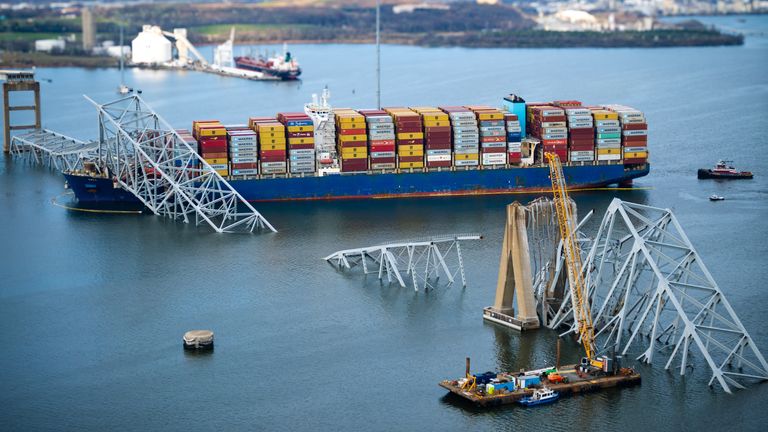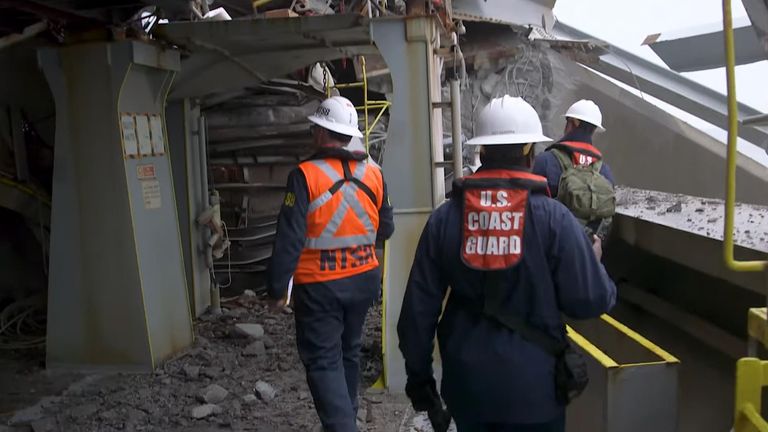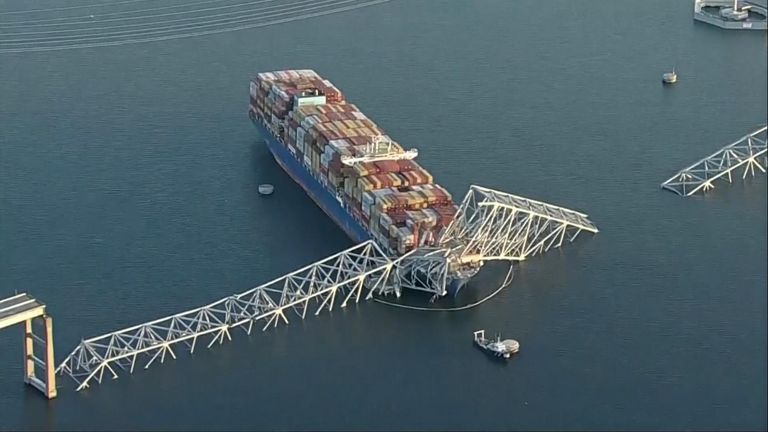Baltimore bridge collapse: Seven floating cranes and more than 30 vessels involved in major salvage operation | US News
A complex salvage operation is under way to remove the wreckage of the Baltimore bridge in a first step towards reopening the vital port and recovering the bodies of the four workers still missing, presumed dead.
Seven floating cranes, including the largest on the Atlantic seaboard, 10 tugs, nine barges, eight salvage vessels and five Coast Guard boats, along with teams of engineers are involved in the mammoth task to clear the twisted metal and concrete remains of the Francis Scott Key Bridge from Maryland’s Patapsco River.
The structure collapsed into the water within seconds on Tuesday after being struck by the Dali, a 300m (985ft) cargo ship, which had lost power.
US Coast Guard rear admiral Shannon Gilreath said experts were trying to work out how to “break that bridge up into the right-sized pieces that we can lift”.
Maryland governor Wes Moore said: “To go out there and see it up close, you realise just how daunting a task this is.
“With a salvage operation this complex – and frankly with a salvation operation this unprecedented – you need to plan for every single moment.”
He said shipping containers aboard the cargo vessel had been ripped apart “like papier-mache” in the crash.
The wreckage has blocked ships from entering or leaving the busy port and also hampered the search for the missing workers.
The governor said: “We have to bring a sense of closure to these families.”
Highlighting the mounting financial cost, he added: “What we’re talking about today is not just about Maryland’s economy, this is about the nation’s economy.
“The port handles more cars and more farm equipment than any other port in this country.”
Read more on Sky News:
Wife of survivor says it’s a ‘miracle’ husband survived’
Two possible causes for the Baltimore bridge catastrophe
Baltimore has ‘very long road ahead’ after bridge disaster
Maryland’s secretary of transportation Paul J Wiedefeld said his department was already planning for rebuilding of the bridge and “considering innovative design, engineering and building methods so that we can quickly deliver this project”.
Meanwhile, the authorities have imposed a no-fly zone over the area with people told to keep drones away.
The victims of the disaster, members of a road crew fixing potholes on the bridge when it was destroyed, were from Mexico, Guatemala, Honduras and El Salvador, officials said.
At least eight people initially went into the water when the ship struck the bridge column, and two of them were rescued.
Divers subsequently recovered the bodies of two men from a pick-up truck in the river, but the extent of the debris and murky underwater conditions have complicated efforts to find the other four workers.
The White House has approved $60m (£48m) in immediate aid, and US President Joe Biden has said the federal government will pay the full cost of rebuilding the road bridge, which was completed in 1977 and carried 30,000 vehicles a day.
The cargo ship, which was managed by Synergy Marine Group, was heading from Baltimore to Sri Lanka at the time of the crash.
It is owned by Grace Ocean Private Ltd and was chartered by Danish shipping giant Maersk.
Synergy said in a statement: “We deeply regret this incident and the problems it has caused for the people of Baltimore and the region’s economy that relies on this vitally important port.”
The firm has said it will continue to co-operate with the investigation.
Of the 21 crew members on the ship, only one was slightly injured and needed stitches.
The huge 86,000-tonne vessel was carrying nearly 4,700 shipping containers.





